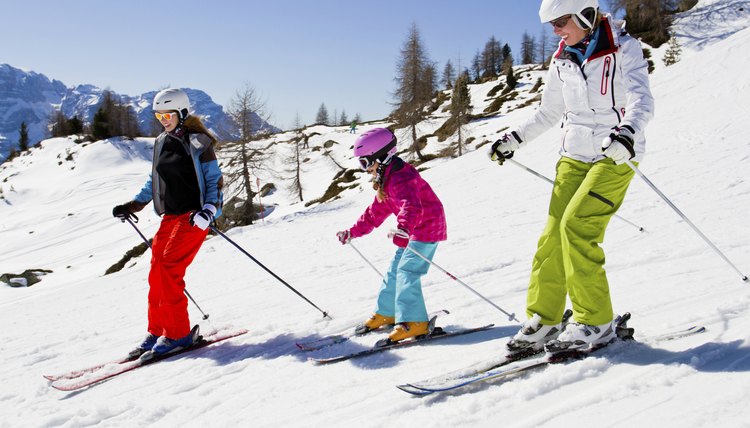The 5 Muscle Groups Used in Skiing

Skiing demands a series of complex interactions between your upper- and lower-body muscles and your central nervous system. Your muscle groups work in concert to perform the primary skiing movements designated by the Professional Ski Instructor's Association. These include balance, edging movements, adding pressure and rotational movement. Your central nervous system controls the sequence in which your muscles are used.
The Core
Your core muscles, which include your transverse abdominal muscles, your multifidus, your internal and external obliques and to some extent, your rectus abdominus help you maintain balance, which is the most essential skiing skill. These muscle groups work as a unit to stabilize your pelvis and spine, while maintaining an upright posture while moving down the slope. When you ride the lift and look down at the slopes, skiers with weak core muscles are easily identifiable by their frequent falls, unstable torsos and flailing arm movements.
Foot-and-Ankle Group
While your core muscles control ski-specific balance, your foot-and-ankle muscle group takes responsibility for the edging, pressure and rotational movements used in skiing. Your feet have intrinsic and extrinsic muscles. The intrinsic muscles include the plantar flexors, which point your toes toward the ground, and your dorsiflexors, which curl your toes toward your shins. Dorsiflexion is more common in skiing, because it helps you keep your shins pressed into the tongue of your ski boot.
The Lower Leg
The extrinsic muscle groups used in skiing are in your lower leg, which is divided into three compartments. The anterior compartment, located in the shins, assists in dorsi flexion, whereas the posterior compartment, located in the calf, assists in plantar flexion. The lateral compartments hold particular importance, because they control eversion, which turns the sole of your foot outward. You perform eversion every time you put your skis on their edges.
Knee Flexors and Extensors
Flexion and extension, or bending and straightening of the leg controls pressure and helps absorb the ground-impact forces of alpine skiing. Your hamstrings, located in the backs of your legs, take on the important task of bending your knees. When your hamstrings perform properly, they protect your anterior cruciate ligament, a highly sensitive knee ligament that has a tendency to snap under pressure. Your quadriceps straighten your legs, stabilize your knee joint and prevent excess knee rotation, explains Robert E. Leach, coauthor of "Alpine Skiing."
The Gluteal Muscles
Your gluteal complex is the most powerful muscle group in the hip area, as well as one of the most essential muscle groups used in skiing. These muscles act as stabilizers and assist in flexion and extension. The gluteus medius, which attaches to the top of your outer thigh, abducts, or moves your leg away from the center of your body. Your gluteal muscles also assist in external leg rotation, which helps perform the rotary movements that steer your skis.
References
Writer Bio
In 1999, Lisa Mercer’s fitness, travel and skiing expertise inspired a writing career. Her books include "Open Your Heart with Winter Fitness" and "101 Women's Fitness Tips." Her articles have appeared in "Aspen Magazine," "HerSports," "32 Degrees," "Pregnancy Magazine" and "Wired." Mercer has a Bachelor of Arts in psychology from the City College of New York.
